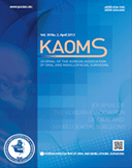Journal of the Korean Association of Oral and Maxillofacial Surgeons
- P-ISSN2234-7550
- E-ISSN2234-5930
- SCOPUS, KCI, ESCI
 ISSN : 2234-7550
ISSN : 2234-7550
Comparison of postoperative paresthesia after sagittal split osteotomy among different fixation methods: a one year follow-up study
Kousha Bakrani (Shiraz University of Medical Sciences, Shiraz)
Farshid Bastami (Shahid Beheshti University of Medical Sciences, Tehran)
Abstract
Objectives: Postoperative paresthesia is a common complication after sagittal split osteotomy (SSO). This study aimed to compare paresthesia among different fixation methods one year postoperative. Materials and Methods: This prospective cohort study assessed subjects in four groups: class II with miniplate fixation (Group 1), class II with three-screw fixation (Group 2), class III with miniplate fixation (Group 3), and class III with three-screw fixation (Group 4). Paresthesia was evaluated one year postoperative based on a 0-10 visual analogue scale. Pearson correlation was used to evaluate associations of age and mandibular movement with paresthesia. ANOVA was used to compare paresthesia among groups. Results: A total of 80 subjects were enrolled, with 20 subjects in each of the four groups. The Pearson correlation test demonstrated a significant correlation between mandibular movement and paresthesia (P=0.001). Comparison of paresthesia among the groups showed significant differences among groups 1 and 2, 2 and 3, and 3 and 4 (P<0.05). Conclusion: The three-screw fixation method led to more paresthesia one year postoperative compared with miniplate fixation. In addition, the magnitude of mandibular movement had a positive correlation with paresthesia.
- keywords
- Mandible, Paresthesia, Sagittal split osteotomy, Skeletal deformity, Inferior alveolar nerve
- Downloaded
- Viewed
- 0KCI Citations
- 0WOS Citations